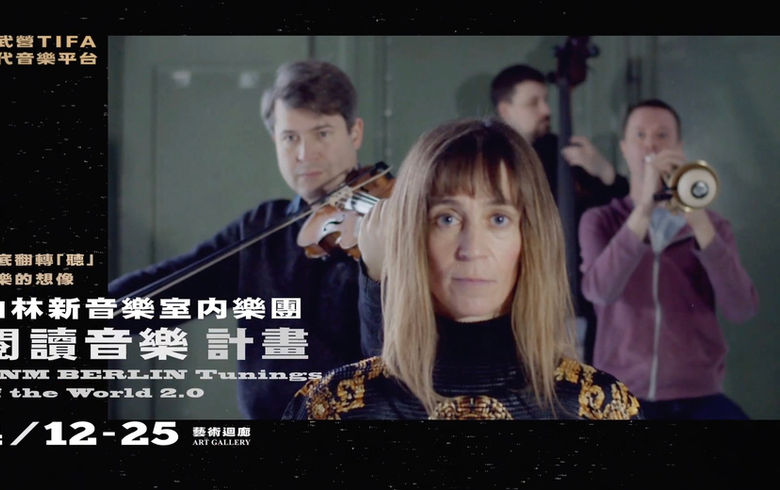2021 Weiwuying TIFAContemporary Music Platform

By Lin Fang-yi
Curator, Weiwuying Contemporary Music Platform
Artist Director, Studio Acht
Asian Female Power in the International Contemporary Music World
"Asian culture" and "female" have persisted as two major fields in art studies. Moreover, the achievements of Asian females in contemporary music have received tremendous attention within the developing context of the international music world. From expressing one's cultural inheritance through systematic training in Western schools, to returning to the exploration and nurturing of one's mother culture post-globalization, Asian female composers have, within the colossal network of the Western music industry, created a rich collection of works in 100 years of new music history through their unique aesthetic and artistic vocabularies.
German music scholar Ulrich Dibelius used 1945, the ending year of WWII, as the starting point for contemporary music and the point of differentiation from ModerneMusik (modern music) before WWII. The War brought a huge impact on social structure and cultural development, wherein the interaction and immigration between countries further accelerated artistic development. Korean composer Younghi Pagh-Paan (1945-) was the first renowned Asian female composer post-war. Like many first-generation artists after the war, after completing her study of musicology and composition at Seoul National University, she won the German Academic Exchange Service and carried the aesthetic influence of her mother culture with her as she headed to Europe, where she learned the cultural impact between East and West and the most avant-garde musical styles. In 1980, she received the attention of the musical world when she presented her large-scale orchestral work Sori at DonaueschingerMusiktagen, the most longstanding modern music festival in Germany, with her composing career thus taking off. Younghi Pagh-Paan's works combine the restraint of traditional Korean culture and the rigorousness of Western music. From the perspective of art-appreciation, one is precisely able to see the artist's aesthetic style and artistic thinking. At the same time, her works withstand academic analysis and are rich in artistic techniques, laying the foundation for her to become a paragon in the later era made up almost exclusively of male composers. Younghi Pagh-Paan is also a prominent teacher in contemporary music history. She has taught for many years at Hochschule für Künste Bremen in Germany, where she created the contemporary music workshop Atelier Neue Musik, which cultivates new composers and performers through the practice and actualization of works. She was also a long-time mentor at Darmstädter Ferienkurse, the most important spot for the cultivation of contemporary music talents. In 2020, she was awarded Großer Berliner Kunstpreis (Berlin Art Prize) and is the only Asian woman to receive the award since the award's establishment in 1948.
In succession to Pagh-Paan, Chinese composer Chen Yi (1953-) was among the first generation to be able to attend university after the Cultural Revolution. She, together with her classmates at Central Conservatory of Music, Tan Dun (1957-), Guo Wenjing (1956-), and Chen Qigang (1951-), were named by the people as the "5th generation composers of China"; they all experienced the "sent-down educated youth" program and had rich experiences in ethnomusicology. Composers of the 5th generation usually go to the US or Europe after completing education in China to learn the avant-garde style of Western music, where the Chinese musical elements and Chinese traditional instruments that they bring along also became a trend in the Western music world. Chen Yi went to the US in 1986, where she studied with Chou Wen-chung. As the only female among the 5th generation composers, Chou did not incorporate large amounts of Chinese folk music in her works like Tan Dun, but instead inherited Chou Wen-chung's development path of using Western avant-garde techniques to explore Chinese aesthetics. Chen Yi also started playing the violin at a young age and thus had a solid foundation in Western music as well as abundant experience playing in the orchestra. Therefore, her works demonstrate a sublime level of artistry in terms of techniques and structures. Chen Yi was awarded the 2006 Pulitzer Prize for Music with Si Ji and was the first Asian composer to win this award. The first post-war generation was rooted in tradition and progressed towards the avant-garde and breaking the norm; thus, one sees both Western musical traditions and traditions of the composers' own countries in their works. Meanwhile the second generation, with globalization and the multimedia brought about by technological advancements, initiated an era where many school of thoughts prospered. The most representative among these composers were Chin Unsuk (1961-) and Tomoko Mukaiyama (1963-).Chin Unsuk majored in composition in Seoul National University and was awarded an international award at an early age. She later received the German Academic Exchange Service to study in Germany. While studying with György Ligeti from 1985 to 1988, she did not participate in any competitions or premier any works; instead, she committed herself to deconstructing post serial techniques that had already become rigid, and through a balance of theory and aesthetic practice, finding her own musical language. Such a metamorphosis is often seen in countries where theory comes before creative expression, which are usually not the mainstream countries that come to mind when one thinks of Western classical music. This is also a necessary process for learning the composition methods of a foreign culture. Chin Unsuk's works do not specifically feature Asian elements or cultural origins; instead, sound art is demonstrated through the use of virtuosic composing techniques. The development of Chin Unsuk's composition career is closely tied with the network of the contemporary music industry, and she is the most active and prominent Asian female composer in today's contemporary music world.
Compared to Chin Unsuk, Tomoko Mukaiyama, a pianist who emerged in the European music world as a contemporary music performer, is not a composer strictly speaking. However, she has participated in interdisciplinary projects that combine music performance, visual art, theater art and the behavioral art for many years. In the international music world, few musicians can compete with her in regards to creativity, artistry, and numbers and scales of creation. Tomoko Mukaiyama's works fully demonstrate the characteristics of what it means to be an international citizen: free of self-imposed national boundaries and the seeking of cultural characteristics; instead, she directly touches upon the core of each art field and closely follows their modern developments.
Also from Japan, Misato Mochizuki (1969-) belongs to the generation that began looking back at one's mother culture after receiving huge amount of culture resources due to globalization. After receiving her master’s degree from University of Tokyo, she continued her studies in Paris, inheriting both French contemporary acoustic colors and Eastern aesthetic thinking. Therefore, in her works one sees both the precision of the West and the freedom of the East. Such a quality that reflects the global cultural development has continued to today. Compared to gaining recognition from mainstream countries, Asian composers of the new generation focus more on self-expression and the development of their own styles. Chinese composers Wang Ying (1976-) and Du Yun (1977) both graduated from the Shanghai Conservatory of Music, after which Wang Ying went to Germany and Du Yun went to the US. Though they undertook drastically different paths of aesthetic development, neither continued to undertake the burden of passing on the Asian culture. Wang Ying combines the merits of German and French contemporary music with Western instruments, traditional Chinese instruments, electronics, and multimedia, creating works with precise structures and acoustic creativity. She does not intentionally exhibit Chinese or Asian traditions, but the Chinese traditional aesthetic language does occasionally present itself in her works. Du Yun, on the other hand, brings the internationality of an artist into full play; and amidst a high-degree of internationalization, she also directly addresses the development topics of non-mainstream culture. Du Yun can be said to be the artist, performer, and curator with the least boundaries, with her works including the styles of hip-hop, Chinese dramas, Western classical music, and pop music. Through curating for and producing projects, she opened a new era where one no longer incorporates the European/American music industry and network as an outsider; instead, the actualization of one's own art is used to establish a new social and development network within the closely knitted structure of the music industry, which is further used to explore one's own cultural context from a global perspective. Du Yun's multi-functional development allowed her to become the second Asian female artist to win the Pulitzer Prize for Music.
Although Asian female composers are not small in number, it is still hard for them to connect with society despite contemporary music being a non-mainstream art form. From the career development of the above composers, we can see how work creation and social network are closely related. They all continued their studies in Europe and the US after coming of age and completing college education in Asia. For them, the real challenge does not lie in leaning new composition techniques and practices, but in the industrial and social structure whose speaking rights are predominantly controlled by mainstream countries and males. They have each built their own reputations and statuses, and as their works continue to be performed around the world, they continue to write new chapters for the Asian female in music history.
Program & Event
2021/04/17|Opening Concert—The Orchestral Works by Unsuk CHIN X Open-talk
2021/04/18|The Minimalism World of Contemporary Virtuosos - Jenny LIN Piano Recital
2021/04/24、25|Resonance: Into the Maze
2021/04/24、25|Here and Now
2021/04/12~25| KNM BERLIN - Tunings of the World 2.0






